Gregory A. Fournier's Blog, page 43
August 20, 2013
Through a Rapist's Eyes - Cautionary Advice for Young Women
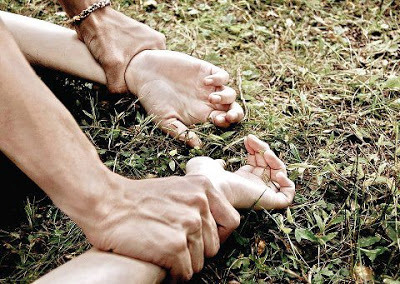
Read this good advice for young women going off to college. It seems that a lot of attackers use similar tactics to get away with rape.
Not many people know how to take care of themselves when faced with such a situation. Everyone should read this, especially each and every woman in this world.
A group of rapists and date rapists in prison were interviewed on what they look for in a potential victim and here are some interesting facts:
1] The first thing men look for in a potential victim is hairstyle. They are most likely to go after a woman with a ponytail, bun, braid or other hairstyle that can easily be grabbed. They are also likely to go after a woman with long hair. Women with short hair are not common targets.
2] The second thing men look for is clothing. They will look for women whose clothing is easy to remove quickly. Many of them carry scissors around to cut clothing.
3] They also look for women using their cell phone, searching through their purse or doing other activities while walking because they are off guard and can be easily overpowered.
4] The number one place women are abducted from/attacked at is in grocery store parking lots.
5] Number two is in office parking lots/garages.
6] Number three is public restrooms.
7] The thing about these men is that they are looking to grab a woman and quickly move her to a second location where they don't have to worry about getting caught.
8] If you put up any kind of a fight at all, they get discouraged
because it only takes a minute or two for them to realize that going after you isn't worth it because it will be time-consuming.
9] These men said they would not pick on women who have umbrellas, or other similar objects that can be used from a distance, in their hands.
10] Keys are not a deterrent because you have to get really close to the attacker to use them as a weapon. So, the idea is to convince these guys you're not worth it.
POINTS THAT YOU SHOULD REMEMBER:
1] If someone is following behind you on a street, in a garage, or with you in an elevator or stairwell, look them in the face and ask them a question, like what time is it, or make general small talk: can't believe it is so cold out here, we're in for a bad winter. Now that you've seen their faces and could identify them in a line- up, you lose appeal as a target.
2] If someone is coming toward you, hold out your hands in front of you and yell Stop or Stay back! Most of the rapists interviewed said they'd leave a woman alone if she yelled or showed that she would not be afraid to fight back. Again, they are looking for an EASY target.
3] If you carry pepper spray, yelling I HAVE PEPPER SPRAY and holding it out will be a deterrent.
4] If someone grabs you, you can't beat them with strength but you can do it by outsmarting them. If you are grabbed around the waist from behind, pinch the attacker either under the arm between the elbow and armpit or in the upper inner thigh - HARD. One woman in a class this guy taught told him she used the underarm pinch on a guy who was trying to date rape her and was so upset she broke through the skin and tore out muscle strands. The guy needed stitches. Try pinching yourself in those places as hard as you can stand it; it really hurts.
5] After the initial hit, always go for the groin. I know from a particularly unfortunate experience that if you slap a guy's parts it is extremely painful. You might think that you'll anger the guy and make him want to hurt you more, but the thing these rapists told our instructor is that they want a woman who will not cause him a lot of trouble. Start causing trouble, and he's out of there.
6] When the guy puts his hands up to you, grab his first two fingers and bend them back as far as possible with as much pressure pushing down on them as possible. The instructor did it to me without using much pressure, and I ended up on my knees and both knuckles cracked audibly.
7] Of course the things we always hear still apply. Always be aware of your surroundings, take someone with you if you can, and if you see any odd behavior, don't dismiss it, go with your instincts. You may feel little silly at the time, but you'd feel much worse if the guy causes you trouble.
FINALLY, PLEASE REMEMBER THESE AS WELL ....
I know you are smart enough to know these pointers, but there will be some who will say, "Hmm, I must remember that" After reading this, forward it to someone you care about. It never hurts to be careful in this crazy world we live in.
1. Tip from Tae Kwon Do: The elbow is the strongest point on your body. If you are close enough to use it, do it.
2. Learned this from a tourist guide to New Orleans : if a robber asks for your wallet and/or purse, DO NOT HAND IT TO HIM. Toss it away from you.... chances are that he is more interested in your wallet and/or purse than you and he will go for the wallet/purse. RUN LIKE MAD IN THE OTHER DIRECTION!
3. If you are ever thrown into the trunk of a car: Kick out the back tail lights and stick your arm out the hole and start waving like crazy. The driver won't see you but everybody else will. This has saved lives.
4. Women have a tendency to get into their cars after shopping, eating, working, etc., and just sit doing their checkbook or making a list, etc. DON'T DO THIS! The predator will be watching you, and this is the perfect opportunity for him to get in on the passenger side, put a gun to your head, and tell you where to go. AS SOON AS YOU CLOSE THE DOORS, LEAVE.
5. A few notes about getting into your car in a parking lot, or parking garage:
a. Be aware. Look around your car as someone may be hiding at the passenger side. Peek into your car, inside the passenger side floor, and in the back seat. DO THIS TOO BEFORE RIDING A TAXI CAB.
b. If you are parked next to a big van, enter your car from the passenger door. Most serial killers attack their victims by pulling them into their vans while the women are attempting to get into their cars.
c. Look at the car parked on the driver's side of your vehicle, and the passenger side. If a male is sitting alone in the seat nearest your car, you may want to walk back into the mall, or work, and get a guard/policeman to walk you back out. IT IS ALWAYS BETTER TO BE PARANOID RATHER THAN DEAD.
6. ALWAYS take the elevator instead of the stairs. Stairwells are horrible places to be alone and the perfect crime spot.
7. If the predator has a gun and you are not under his control, ALWAYS RUN! The predator will only hit you (a running target) 4 in 100 times, and even then, it most likely WILL NOT be a vital organ. RUN!
8. As women, we are always trying to be sympathetic: STOP IT! It may get you raped or killed. Ted Bundy, the serial killer, was a good-looking, well educated man, who ALWAYS played on the sympathies of unsuspecting women. He walked with a cane, or a limp, and often asked "for help" into his vehicle or with his vehicle, which is how he abducted his victims.
Please forward this to all the women you know. It may save a life. A candle is not dimmed by lighting another candle.
Send this to any woman you know that may need to be reminded that we live in a crazy world and it's better safe than sorry.
Helping hands are better than Praying Lips. Give us your helping hand.
SHARE THIS WITH ALL YOUR FRIENDS WHO HAVE DAUGHTERS GOING TO COLLEGE THIS AUTUMN.
Published on August 20, 2013 19:07
August 15, 2013
My Summer in Detroit - 2013
 Twilight in DetroitI just returned from several weeks in and around my hometown of Detroit, Michigan. I was doing field research with my Detroit counterpart, Ryan M. Place. For the last several years, he and I have been seeking information and documents related to the John Norman Collins coed killing cases of the late nineteen-sixties.
Twilight in DetroitI just returned from several weeks in and around my hometown of Detroit, Michigan. I was doing field research with my Detroit counterpart, Ryan M. Place. For the last several years, he and I have been seeking information and documents related to the John Norman Collins coed killing cases of the late nineteen-sixties.I was in the Detroit area for three weeks in June and July and drove 2,300 miles in my rental car crisscrossing much of Michigan. Ryan and I went wherever we could to find individuals with credible information who were willing to tell their stories. We were very busy.
But because of the somber and dark nature of our subject matter, we made it a point to get out and do something a little different each week. The first week we went to the Elmwood Cemetery in Detroit to meet with Canadian filmmaker, Mark Dal Bianco.
***
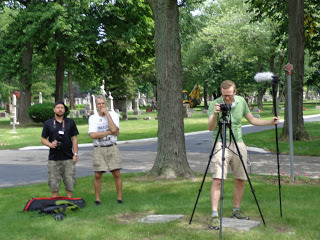 At Elmwood Cemetery for Zug shoot.
At Elmwood Cemetery for Zug shoot.Mark is making an indie documentary film about Zug Island and its environmental effects on Canada and the United States. After a brief meeting with Stewart McMillin (noted Detroit tour guide), Mark Dal Bianco, and Ryan, we all headed to the burial plot of Samuel Zug, the man Zug Island is named after.
On the strength of the introduction of my book, Zug Island: A Detroit Riot Novel, Mark wanted me to give a brief biography of Mr. Zug, at the site of his grave marker.
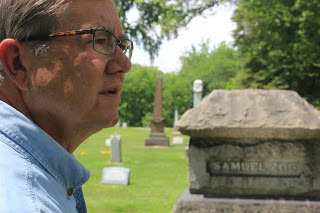
When we were finished there, we drove over to the ghost town of Delray which once existed outside the blast furnace and coke oven plant. I filmed a segment talking about working conditions on the island in 1967, the year of the Detroit riots.
The documentary will go on from there and delve into some of the current controversies Zug Island finds itself at the center of with its neighbors. Notably, the Windsor Hum.
We were very lucky to catch a break in the rainy weather for the shoot. Afterwards, we had a wonderful dinner at the Polish Village Cafe in Hamtramck, a city within the city limits of Detroit. It turned out to be a lovely day.
***
On the second week of our quest for knowledge and insight into the John Norman Collins case, we went on a field trip to where Collins began his life sentence behind bars, Jackson Prison. The Seven-Block (1934-2007) tour was led by prison docent Judy Gail Krasnow.
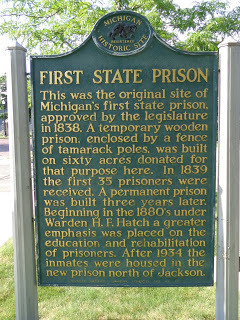 We were taken on a bus to the Michigan Theater in Jackson to view a short film history of the various incarnations of the Jackson prison system over the years, and then we listened to an orientation lecture before going over to Seven-Block.
We were taken on a bus to the Michigan Theater in Jackson to view a short film history of the various incarnations of the Jackson prison system over the years, and then we listened to an orientation lecture before going over to Seven-Block. Our docent, Judy, asked the thirty or so people on the tour if any of us were from Jackson, Michigan. A smattering of hands went up. "Do we have any former guards or prison employees in the crowd today?" Several more hands went up.
Ryan and I were sitting in the front row when she asked me where I was from. "Originally from Detroit," I said, "but now I live in San Diego."
 Old Jackson Prison Walls"Really?" she said, in surprise. "I just returned from visiting friends in San Diego."
Old Jackson Prison Walls"Really?" she said, in surprise. "I just returned from visiting friends in San Diego.""No!"
Judy held up her Seaport Village shopping bag to prove it. "What, may I ask, brings you here to Jackson prison today?"
I was hoping she would ask me that. "I'm doing research and writing a book on John Norman Collins."
I thought her eyes were going to pop out of her head. "You're kidding me."
"Nope!"
Turns out that Judy was given a private prison tour of Marquette Prison in Michigan's Upper Peninsula just a couple of months before, and she was able to meet briefly with Collins in front of his cell. She found Mr. Collins to be alert and engaging.
"Let's talk after the tour," she said, to me.
And talk we did. When The Rainy Day Murders is released, Judy will see about getting it carried in the prison stores. Not a bad outing for a field trip.
They serve a box lunch on the tour of Seven-Block in the prison mess area between the five galleries of cells that face across from each other. Nice touch!
For more information and reservations on Jackson Prison Tours, contact Judy Gail Krasnow at 517-795-2112, or check out the link below.
***
 End of an era - old Tiger StadiumI have a deep childhood memory of walking into a gray cavernous building that was dark and shadowy inside with screened ramps and overhead walkways. The air was heavy with tobacco smoke and stale with Strohs beer vapor. I remember walking along among a throng of adults mostly. I didn't know where we were headed for sure, but I followed my dad with my little brother in tow.
End of an era - old Tiger StadiumI have a deep childhood memory of walking into a gray cavernous building that was dark and shadowy inside with screened ramps and overhead walkways. The air was heavy with tobacco smoke and stale with Strohs beer vapor. I remember walking along among a throng of adults mostly. I didn't know where we were headed for sure, but I followed my dad with my little brother in tow.We finally made it. I saw the diamond for the first time and the vibrant field glistened like the emerald jewel it was. I came out into the comforting light of a Sunday afternoon Tiger game at Briggs Stadium. Man, I never knew a Coke, a hot dog, and a bag of peanuts could taste so good.
 On the last week of my latest Michigan trip in July, I went with friends and saw my first Tiger game in the modern Comerica Park.
On the last week of my latest Michigan trip in July, I went with friends and saw my first Tiger game in the modern Comerica Park. The stadium is airy and open, not like the fabled Tiger/Briggs Stadium of the last century, and the cigarette and cigar smokers are gone.
 After a week of heavy rain, the weather cleared on game day and Tigers fans were out in force ready to take on the White Sox.
After a week of heavy rain, the weather cleared on game day and Tigers fans were out in force ready to take on the White Sox.But before the game started, my friends and I split a pizza and drank a couple of beers at a local bar to avoid the high cost of stadium concessions.
In the old days, a person could have a great outing with ten or twenty dollars in his pocket. Now that's what a beer and a hot dog costs at the concession stands. Everything is expensive these days. But Detroit beat Chicago, so there was joy in Mudville, that night anyway. Go Tigers!
For information on the current schedule of Detroit tours, connect with Stewart McMillin's website: mcmillintours.com
For information on Jackson Prison tours, contact: https://historicprisontours.com/category/uncategorized
For authentic Polish food in the Detroit area, go to Hamtramck and visit Polish Village Cafe: PolishVillageCafe.us
Published on August 15, 2013 15:32
August 11, 2013
Samuel Zug - The Man Behind the Island
 At the end of June 2013, I was asked by Canadian filmmaker, Mark Dal Bianco, to give a brief biography of Samuel Zug, the man who Zug Island is named after.
At the end of June 2013, I was asked by Canadian filmmaker, Mark Dal Bianco, to give a brief biography of Samuel Zug, the man who Zug Island is named after. The filmmaker is producing a documentary on the environmental impact of the island on the surrounding areas of Detroit and Windsor.
Mr. Zug is thought by some people to have been an industrialist, but that couldn't be further from the truth. He was a devout Presbyterian who took an interest in politics and human rights.
In 1836 at the tender age of twenty years old, Samuel Zug came to Detroit, Michigan from Cumberland County, Pennsylvania. Using money he saved as a bookkeeper in the Pittsburgh area, he went into the furniture making business with Marcus Stevenson, a Detroit investor.
The prospect of endless stands of pine, oak and maple trees as raw material, and convenient access to Eastern markets by way of the Detroit River for their finished products, made Detroit an ideal place for a young man to make his fortune.
But in 1859 after twenty-three years in the furniture business, his partnership with Stevenson was dissolved leaving Samuel Zug a wealthy man to pursue real estate and political ambitions.
In 1859 (or 1876 depending on which source you choose), Samuel Zug purchased 325 acres of land along the Detroit River from Michigan's second Territorial governor, General Lewis B. Cass. Over 250 acres of the parcel was marshland with a sulfur spring bubbling up 1,200 barrels of mineral water a day.
The marshy peninsula of land was originally part of the city of Delray, until it was annexed by Detroit in 1901. In unrecorded time, the land was rumored to have been an ancient burial site for a number of native American tribes who were known to inhabit the area, though this long held belief has never been proven by any authenticated archaeological finds.
Samuel Zug and his wife Anna hoped to build a mansion on the island, but after ten years they decided that the marshland and natural sulfur spring on the site proved too much for them to endure.
They left the land to the red fox, the water fowl, the muskrats, and the mosquitoes. The croaking frogs and the singing insects were left to serenade the damp night air because the island was virtually uninhabitable.
In 1888, Samuel Zug authorized the River Rouge River Improvement Company to cut a small canal at the south end of his land. Known by locals as Mud Run, it was dredged out sixty feet wide and eight feet deep.
 Short Cut Canal at bottom of map was Mud Run.
Short Cut Canal at bottom of map was Mud Run.The Zug family peninsula became a man-made island overnight separating it from the north end of Ecorse Township. The channel improved the flow of the Rouge River into the Detroit River, but it did little to circulate the water around the newly formed island, leaving a slow-moving backwater.
On December 26, 1889, Samuel Zug died leaving his holdings to his wife, Anne, who died on June 10th,1891. It has been reported widely that Mr. Zug died in 1896. My source is the date given on his huge tombstone in Detroit's Elmwood Cemetery.

It is presumed that the Zug heirs sold the island for $300,000 to George Brady and Charles Noble, who wanted to use the site for an industrial dumping ground. The island was diked with interlocking steel panels and back-filled with construction rubble and dredging waste to raise the ground above the water table and reclaim the land from its natural state.
Heavy industry was about to move onto the island but Mr. Zug would never live to see it. The island's namesake was "Waiting for the Coming of Our Lord" as the inscription on the side of his grave marker proclaims.
In addition to being a bookkeeper and the owner of a successful furniture manufacturing company, Samuel Zug is also credited with being one of the founding members of the Republican Party, which was considered to be the progressive party of the day. Their first official meeting took place on July 6, 1854, in Jackson, Michigan.
The Republicans were an abolitionist party that came to national attention when they won 33% of the presidential vote from the Democrats and the Whigs in 1856. Four years later in 1860, they broke through the two-party system and elected Abraham Lincoln to the White House.
Samuel Zug was an anti-slavery advocate long before Lincoln was elected and The Civil War began. He had bought and set aside a parcel of land for refugee slaves in the city of Amherstburg in Ontario, Canada, a destination on the Underground Railroad. What other support he gave to the Abolitionist Movement is shrouded in the dim history and whispers of the unrecorded past.
At the time of his death, Samuel Zug was unaware of the mighty industrial complex his soggy marshland would become. He would never know the history Zug Island would help make possible, or the long term environmental impact the rust belt industry there would have on the area and its people.
 In Detroit's Elmwood Cemetery
In Detroit's Elmwood CemeteryCheck out Zug Island: A Detroit Riot Novel about my experiences working on the island during the historic summer of 1967 when all Hell broke loose in the Motorcity: http://www.zugislandthenovel.com/
Published on August 11, 2013 18:45
August 7, 2013
Ghost of a Soul (Part Four of Four)
The integration of mind, body, and soul is the business of growing up human. Our notions of right and wrong become established as our conscience develops in childhood. The Golden Rule of "Do unto others - as you would have done unto you" travels well across many religions and cultures around the globe. This may be the guiding principle that grounds us to society and binds us to other people.
Dr. Martha Stout, Ph D, a clinical psychologist and faculty member in the department of psychiatry at Harvard Medical School, has convincing data to support her belief that ninety-six percent of the population has a conscience and some attachment to other humans. Fully four percent of the population are not inhibited or encumbered by conscience and suffer from attachment disorder - the inability to relate to people in meaningful and lasting ways. These people go through the motions of life without fully participating in it. It is as if they are absent from their own lives.

Their emptiness gnaws away at them from the inside. Unexposed, it is fed by a need to dominate and control others to meet their egocentric ends. Life becomes a power play where "winning" means everything. Dr. Stout makes the keen observation that "If all you had ever felt toward another person were the cold wish to 'win,' how would you understand the meaning of love, of friendship, of caring?"
Sociopaths are preoccupied with themselves. Their narcissism is compounded by their lack of feeling for other people. Their social detachment can range from callous indifference to protracted dehumanization. They may play on our pity when the occasion calls for it, but their game is not getting our sympathy, it is drawing us into their web of influence to accomplish their own ends. Being master manipulators, when they have their prey in their clutches, the demon in them is aroused and all Hell breaks loose where they play out their God or Satan fantasies of omnipotence.
Dr. Stout's book, the sociopath next door (sic), suggests ways people - young women in particular - should deal with the sociopathic personality. I have adapted them below to reduce her list of thirteen to ten.
Accept that some people literally have no conscience. It's not your fault!Don't let preconceived notions of people's roles (doctors, teachers, clergy, policemen, family, etc) interfere with your instincts. Listen to your inner voice. If something doesn't seem right or feel right about a person, don't ignore it.A series of broken promises, neglected responsibilities, or misunderstandings are warning signs. Strike three and you're out!Question authority! (related to #1) Blind obedience is dangerous. Dr. Stanley Milgram from Yale University conducted the famous "Authority Compliance" study in 1961-1962. He discovered that "at least six out of ten people will blindly obey to the bitter end an official looking authority in their midst." In this case, a "researcher" in a white lab coat clutching a clipboard.Suspect over-exaggerated flattery or concern for others called "counterfeit charm." It often signals an "intent to manipulate."Don't play their game. Avoid contact or communication with them and document everything.Question their appeals for pity, and curtail your need to be polite or to speak with everyone. Don't try to save them. Their behavior is not your fault, unless you enable them.Never be a party to a sociopath's deceptions or help him/her conceal their true nature. If you do, from that moment on, you are ensnared in their web.Defend your personhood and your mental health. People who seek to diminish you have an infinite capacity to inflict harm and damage at your expense. Get some help!
Dr. Martha Stout, Ph D, a clinical psychologist and faculty member in the department of psychiatry at Harvard Medical School, has convincing data to support her belief that ninety-six percent of the population has a conscience and some attachment to other humans. Fully four percent of the population are not inhibited or encumbered by conscience and suffer from attachment disorder - the inability to relate to people in meaningful and lasting ways. These people go through the motions of life without fully participating in it. It is as if they are absent from their own lives.

Their emptiness gnaws away at them from the inside. Unexposed, it is fed by a need to dominate and control others to meet their egocentric ends. Life becomes a power play where "winning" means everything. Dr. Stout makes the keen observation that "If all you had ever felt toward another person were the cold wish to 'win,' how would you understand the meaning of love, of friendship, of caring?"
Sociopaths are preoccupied with themselves. Their narcissism is compounded by their lack of feeling for other people. Their social detachment can range from callous indifference to protracted dehumanization. They may play on our pity when the occasion calls for it, but their game is not getting our sympathy, it is drawing us into their web of influence to accomplish their own ends. Being master manipulators, when they have their prey in their clutches, the demon in them is aroused and all Hell breaks loose where they play out their God or Satan fantasies of omnipotence.
Dr. Stout's book, the sociopath next door (sic), suggests ways people - young women in particular - should deal with the sociopathic personality. I have adapted them below to reduce her list of thirteen to ten.
Accept that some people literally have no conscience. It's not your fault!Don't let preconceived notions of people's roles (doctors, teachers, clergy, policemen, family, etc) interfere with your instincts. Listen to your inner voice. If something doesn't seem right or feel right about a person, don't ignore it.A series of broken promises, neglected responsibilities, or misunderstandings are warning signs. Strike three and you're out!Question authority! (related to #1) Blind obedience is dangerous. Dr. Stanley Milgram from Yale University conducted the famous "Authority Compliance" study in 1961-1962. He discovered that "at least six out of ten people will blindly obey to the bitter end an official looking authority in their midst." In this case, a "researcher" in a white lab coat clutching a clipboard.Suspect over-exaggerated flattery or concern for others called "counterfeit charm." It often signals an "intent to manipulate."Don't play their game. Avoid contact or communication with them and document everything.Question their appeals for pity, and curtail your need to be polite or to speak with everyone. Don't try to save them. Their behavior is not your fault, unless you enable them.Never be a party to a sociopath's deceptions or help him/her conceal their true nature. If you do, from that moment on, you are ensnared in their web.Defend your personhood and your mental health. People who seek to diminish you have an infinite capacity to inflict harm and damage at your expense. Get some help!
Published on August 07, 2013 06:44
August 2, 2013
Sociopathic Charm (Part Three of Four)
People labeled as sociopaths are often superficially described as charming. Even after their outrages have been discovered, many people seem dumbstruck, despite the evidence. It is part of the Dr. Jekyll and Mr. Hyde nature of their personality disorder that enables them to deceive other people so easily. They are natural actors because deception and manipulation are second nature to them.
 Sociopaths are people with an uncanny ability to access weakness and vulnerability. They know us better than we know them. They read and study their victims - this is their great advantage. Their propensity to exploit our weaknesses is their hidden skill; once they target their prey, their victims are compromised and defenseless. People who recognize or see through a predator's deceptions are assiduously avoided. Discovery is the last thing a sociopath wants.
Sociopaths are people with an uncanny ability to access weakness and vulnerability. They know us better than we know them. They read and study their victims - this is their great advantage. Their propensity to exploit our weaknesses is their hidden skill; once they target their prey, their victims are compromised and defenseless. People who recognize or see through a predator's deceptions are assiduously avoided. Discovery is the last thing a sociopath wants.
But that speaks to them. What about us? Why do so many of us seem vulnerable? As with many things in life, there is no easy answer. One explanation may be that most people have a mild affinity for danger and a hunger for excitement to punctuate their otherwise mundane lives.
Most people enjoy "controlled" risks. We love cheap thrills we can get an emotional rush from and then return to the safety of our homes. Vicarious experiences from action and thriller fantasies on the silver screen, to riding the latest and greatest amusement park attractions, fill this void for many of us. Still, others prefer creating murder and mayhem in the guise of video games in the privacy of their own homes, or living vicariously through the exploits of their sport heroes.
American pop culture presents a high octane lifestyle of the rich and famous, often fueled by drugs, alcohol, and conspicuous wealth, that creates an unrealistic expectation for success which most Americans can never achieve. We idolize famous actors, successful athletes, and people with money. We long for our own sense of celebrity. Anything to quell the incipient boredom of our conventional lives. We hunger for excitement, so most of us are willing to take the occasional risk.
Part of our American folklore informs us that dangerous people are charismatic. Going for the "bad boy" seems like a coming of age ritual for many young women in our culture - the proverbial moth attracted to the flame. How many intelligent women get into relationships with men who aren't as smart as they are because the man may be perceived as exciting, sexy, or notorious? The answer is "Too many!"
Often, these guys undermine other people's faith in themselves with a technique called "gaslighting," a term derived from the movie Gaslight with Ingrid Bergman and Charles Boyer - a husband tries to make his wife go insane by manipulating her self-doubt. It has since become a term used in clinical psychology. When someone or something doesn't feel right to you - go with your instincts - don't ignore warning signs.
Another thing that makes people vulnerable is that we are irrationally influenced by a person's appearance, especially people in positions of authority and in uniform. Our conventional wisdom insists that "You can't judge a book by its cover," but we do this routinely.
Sociopaths make full use of social and professional roles which provide a "ready made mask." Most people seldom look behind the mask, and they readily accept the superficial trappings of success. Women need to be more discerning in their personal lives and take off their blinders. Don't be an enabler and a party to your own emotional and physical destruction. Passivity is what sociopaths thrive on.
 Sociopaths are people with an uncanny ability to access weakness and vulnerability. They know us better than we know them. They read and study their victims - this is their great advantage. Their propensity to exploit our weaknesses is their hidden skill; once they target their prey, their victims are compromised and defenseless. People who recognize or see through a predator's deceptions are assiduously avoided. Discovery is the last thing a sociopath wants.
Sociopaths are people with an uncanny ability to access weakness and vulnerability. They know us better than we know them. They read and study their victims - this is their great advantage. Their propensity to exploit our weaknesses is their hidden skill; once they target their prey, their victims are compromised and defenseless. People who recognize or see through a predator's deceptions are assiduously avoided. Discovery is the last thing a sociopath wants.But that speaks to them. What about us? Why do so many of us seem vulnerable? As with many things in life, there is no easy answer. One explanation may be that most people have a mild affinity for danger and a hunger for excitement to punctuate their otherwise mundane lives.
Most people enjoy "controlled" risks. We love cheap thrills we can get an emotional rush from and then return to the safety of our homes. Vicarious experiences from action and thriller fantasies on the silver screen, to riding the latest and greatest amusement park attractions, fill this void for many of us. Still, others prefer creating murder and mayhem in the guise of video games in the privacy of their own homes, or living vicariously through the exploits of their sport heroes.
American pop culture presents a high octane lifestyle of the rich and famous, often fueled by drugs, alcohol, and conspicuous wealth, that creates an unrealistic expectation for success which most Americans can never achieve. We idolize famous actors, successful athletes, and people with money. We long for our own sense of celebrity. Anything to quell the incipient boredom of our conventional lives. We hunger for excitement, so most of us are willing to take the occasional risk.
Part of our American folklore informs us that dangerous people are charismatic. Going for the "bad boy" seems like a coming of age ritual for many young women in our culture - the proverbial moth attracted to the flame. How many intelligent women get into relationships with men who aren't as smart as they are because the man may be perceived as exciting, sexy, or notorious? The answer is "Too many!"
Often, these guys undermine other people's faith in themselves with a technique called "gaslighting," a term derived from the movie Gaslight with Ingrid Bergman and Charles Boyer - a husband tries to make his wife go insane by manipulating her self-doubt. It has since become a term used in clinical psychology. When someone or something doesn't feel right to you - go with your instincts - don't ignore warning signs.
Another thing that makes people vulnerable is that we are irrationally influenced by a person's appearance, especially people in positions of authority and in uniform. Our conventional wisdom insists that "You can't judge a book by its cover," but we do this routinely.
Sociopaths make full use of social and professional roles which provide a "ready made mask." Most people seldom look behind the mask, and they readily accept the superficial trappings of success. Women need to be more discerning in their personal lives and take off their blinders. Don't be an enabler and a party to your own emotional and physical destruction. Passivity is what sociopaths thrive on.
Published on August 02, 2013 20:12
July 29, 2013
The Two Faces of Evil - Identifying Sociopaths (Part Two of Four)
Broadly defined, a sociopath is a person without conscience - a person who does not experience guilt like most people. Sociopathy is a "non-correctable disfigurement of a person's character." In its extreme manifestation - it leads to psychopathic behavior, the subtext of my next book The Rainy Day Murders.
In my last post, I cited a statistic from Martha Stout's fascinating study, the sociopath next door (sic). She convincingly states that one in twenty-five people are sociopaths - that equates to four percent. Of that segment of the population, roughly twenty percent are behind bars. What of the other eighty percent? Where do they hide?

The answer is chilling - at home, at work, and at large! The successful achievers of this group might go into high finance, high government office, the board rooms of corporate America, and of course, the military. These are high-octane professions where conscience is not a part of the collective dialogue - failure is not an option - their game is not culpability - it is winning at all costs.
Most garden variety sociopaths do not play out their schemes on so vast a stage. At work, they harass and intimidate their co-workers with mean spirited mind games - people in positions of petty authority are known for this. At home, they extract their pound of flesh behind closed doors - usually secure in the knowledge that the fear and shame of their victims will insure their family secrets. Many sociopaths are known for their ability to charm and deceive people. How do we recognize these predators before they do us serious harm?
Here are ten traits to look for. If three or more seem to apply, watch yourself:
Sociopaths are narcissists who know the words but not the music of life.Something is missing from their "genetic marbling." They suffer from attachment disorder.They are easily bored and need continual external stimulation.They are not comfortable in their own skin.They are absolutely self-involved and high-strung.They tend toward hypochondria and "pity plays."They are not team players.They show unremitting self-interest.They use and abuse people with impunity.They are manipulators. Other than that, they look just like the rest of us. Why are sociopaths and psychopaths so often described as charming? Look for the answer in my next post. It may surprise you.
In my last post, I cited a statistic from Martha Stout's fascinating study, the sociopath next door (sic). She convincingly states that one in twenty-five people are sociopaths - that equates to four percent. Of that segment of the population, roughly twenty percent are behind bars. What of the other eighty percent? Where do they hide?

The answer is chilling - at home, at work, and at large! The successful achievers of this group might go into high finance, high government office, the board rooms of corporate America, and of course, the military. These are high-octane professions where conscience is not a part of the collective dialogue - failure is not an option - their game is not culpability - it is winning at all costs.
Most garden variety sociopaths do not play out their schemes on so vast a stage. At work, they harass and intimidate their co-workers with mean spirited mind games - people in positions of petty authority are known for this. At home, they extract their pound of flesh behind closed doors - usually secure in the knowledge that the fear and shame of their victims will insure their family secrets. Many sociopaths are known for their ability to charm and deceive people. How do we recognize these predators before they do us serious harm?
Here are ten traits to look for. If three or more seem to apply, watch yourself:
Sociopaths are narcissists who know the words but not the music of life.Something is missing from their "genetic marbling." They suffer from attachment disorder.They are easily bored and need continual external stimulation.They are not comfortable in their own skin.They are absolutely self-involved and high-strung.They tend toward hypochondria and "pity plays."They are not team players.They show unremitting self-interest.They use and abuse people with impunity.They are manipulators. Other than that, they look just like the rest of us. Why are sociopaths and psychopaths so often described as charming? Look for the answer in my next post. It may surprise you.
Published on July 29, 2013 14:03
July 24, 2013
Dancing with Devils (Part One of Four)
Since September of 2011, my research partner and I have been investigating the John Norman Collins murders in the Ypsilanti and Ann Arbor area between July of 1967 through July of 1969. These seven murders of young women became know as the Co-Ed Killings and have since become a local legend - partly because five of the murders are as yet unsolved - partly because of shoddy police work. Despite early media attention nationally, the trial was overshadowed by the Tate/Bianca murders and the Charles Manson family, which occurred at the same time as the Collins trial.
My research into this matter includes studies of many of the most infamous serial killers, sex criminals, sociopaths, and pathological narcissists in twentieth-century America - almost exclusively angry white males. If ever there was a Rogue's Gallery in Hell, this collection of psychopaths would make their blood run cold.
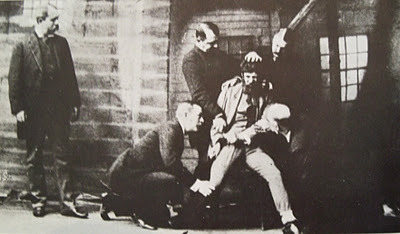
What makes these people different from the rest of us? They lack something called a conscience. These people are lost in a deep and dark existential void where their actions don't have consequences for them - until they are caught, of course. Then they justify their crimes. These people live in a mirrored reality where they are in control - where they are God.
Dr. Martha Stout, PhD, in her book, the sociopath next door (sic), convincingly purports that one in twenty-five people are sociopathic. That is four percent of the population. Many of these people find their niche in society, but too many others carve their way into our consciousness. At their best, they manipulate and use people heartlessly - at their worst, they unleash havoc and horror on an unprotected and terrified public.
What is even more scary is that most of these characters have charm and cunning to mask their heinous acts and desires. Reminds me of Lady Macbeth's advice to her husband, "Appear the innocent flower, but be the serpent underneath." Even in Shakespeare's time, this "deceptive" feature of psychopaths was known. More the pity, there is no known cure for their madness. But when push comes to shove - Beware! - they will stop at nothing to manipulate reality to suit themselves and satisfy their ravenous rage against a society that hasn't learned to appreciate or acknowledge them.
The study of sociopathy is in its early stages, and there are many unanswered questions about it. How do we identify sociopaths? Once we identify them, what do we do about them? How can society protect itself?
Lawyers avoid using the term in court because it has not been precisely defined. The term "serial killer" was not used in court until the 1980's, when an FBI man used it in court to describe the dramatic increase of this crime after World War Two. In Colin Wilson's incisive work, The History of Murder, he states that the FBI estimates serial killers kill 300 to 500 people yearly in America.
People just don't become killers. What makes them that way? And if there are natural born killers among us, surely that tendency displays itself early in their lives. Why isn't sociopathy addressed in public schools? We give lip service against bullies, but what is done with these kids who prey on other students - driving an increasing number to suicide? More often than not, we simply transfer them to another school and seal their records? Presently, there is no known treatment to cure these demons among us, but ignoring them is not an option.
My research into this matter includes studies of many of the most infamous serial killers, sex criminals, sociopaths, and pathological narcissists in twentieth-century America - almost exclusively angry white males. If ever there was a Rogue's Gallery in Hell, this collection of psychopaths would make their blood run cold.

What makes these people different from the rest of us? They lack something called a conscience. These people are lost in a deep and dark existential void where their actions don't have consequences for them - until they are caught, of course. Then they justify their crimes. These people live in a mirrored reality where they are in control - where they are God.
Dr. Martha Stout, PhD, in her book, the sociopath next door (sic), convincingly purports that one in twenty-five people are sociopathic. That is four percent of the population. Many of these people find their niche in society, but too many others carve their way into our consciousness. At their best, they manipulate and use people heartlessly - at their worst, they unleash havoc and horror on an unprotected and terrified public.
What is even more scary is that most of these characters have charm and cunning to mask their heinous acts and desires. Reminds me of Lady Macbeth's advice to her husband, "Appear the innocent flower, but be the serpent underneath." Even in Shakespeare's time, this "deceptive" feature of psychopaths was known. More the pity, there is no known cure for their madness. But when push comes to shove - Beware! - they will stop at nothing to manipulate reality to suit themselves and satisfy their ravenous rage against a society that hasn't learned to appreciate or acknowledge them.
The study of sociopathy is in its early stages, and there are many unanswered questions about it. How do we identify sociopaths? Once we identify them, what do we do about them? How can society protect itself?
Lawyers avoid using the term in court because it has not been precisely defined. The term "serial killer" was not used in court until the 1980's, when an FBI man used it in court to describe the dramatic increase of this crime after World War Two. In Colin Wilson's incisive work, The History of Murder, he states that the FBI estimates serial killers kill 300 to 500 people yearly in America.
People just don't become killers. What makes them that way? And if there are natural born killers among us, surely that tendency displays itself early in their lives. Why isn't sociopathy addressed in public schools? We give lip service against bullies, but what is done with these kids who prey on other students - driving an increasing number to suicide? More often than not, we simply transfer them to another school and seal their records? Presently, there is no known treatment to cure these demons among us, but ignoring them is not an option.
Published on July 24, 2013 15:35
Dancing with Devils (Part one of Four)
Since September of 2011, my research partner and I have been investigating the John Norman Collins murders in the Ypsilanti and Ann Arbor area between July of 1967 through July of 1969. These seven murders of young women became know as the Co-Ed Killings and have since become a local legend - partly because five of the murders are as yet unsolved - partly because of shoddy police work. Despite early media attention nationally, the trial was overshadowed by the Tate/Bianca murders and the Charles Manson family, which occurred at the same time as the Collins trial.
My research into this matter includes studies of many of the most infamous serial killers, sex criminals, sociopaths, and pathological narcissists in twentieth-century America - almost exclusively angry white males. If ever there was a Rogue's Gallery in Hell, this collection of psychopaths would make their blood run cold.

What makes these people different from the rest of us? They lack something called a conscience. These people are lost in a deep and dark existential void where their actions don't have consequences for them - until they are caught, of course. Then they justify their crimes. These people live in a mirrored reality where they are in control - where they are God.
Dr. Martha Stout, PhD, in her book, the sociopath next door (sic), convincingly purports that one in twenty-five people are sociopathic. That is four percent of the population. Many of these people find their niche in society, but too many others carve their way into our consciousness. At their best, they manipulate and use people heartlessly - at their worst, they unleash havoc and horror on an unprotected and terrified public.
What is even more scary is that most of these characters have charm and cunning to mask their heinous acts and desires. Reminds me of Lady Macbeth's advice to her husband, "Appear the innocent flower, but be the serpent underneath." Even in Shakespeare's time, this "deceptive" feature of psychopaths was known. More the pity, there is no known cure for their madness. But when push comes to shove - Beware! - they will stop at nothing to manipulate reality to suit themselves and satisfy their ravenous rage against a society that hasn't learned to appreciate or acknowledge them.
The study of sociopathy is in its early stages, and there are many unanswered questions about it. How do we identify sociopaths? Once we identify them, what do we do about them? How can society protect itself?
Lawyers avoid using the term in court because it has not been precisely defined. The term "serial killer" was not used in court until the 1980's, when an FBI man used it in court to describe the dramatic increase of this crime after World War Two. In Colin Wilson's incisive work, The History of Murder, he states that the FBI estimates serial killers kill 300 to 500 people yearly in America.
People just don't become killers. What makes them that way? And if there are natural born killers among us, surely that tendency displays itself early in their lives. Why isn't sociopathy addressed in public schools? We give lip service against bullies, but what is done with these kids who prey on other students - driving an increasing number to suicide? More often than not, we simply transfer them to another school and seal their records? Presently, there is no known treatment to cure these demons among us, but ignoring them is not an option.
My research into this matter includes studies of many of the most infamous serial killers, sex criminals, sociopaths, and pathological narcissists in twentieth-century America - almost exclusively angry white males. If ever there was a Rogue's Gallery in Hell, this collection of psychopaths would make their blood run cold.

What makes these people different from the rest of us? They lack something called a conscience. These people are lost in a deep and dark existential void where their actions don't have consequences for them - until they are caught, of course. Then they justify their crimes. These people live in a mirrored reality where they are in control - where they are God.
Dr. Martha Stout, PhD, in her book, the sociopath next door (sic), convincingly purports that one in twenty-five people are sociopathic. That is four percent of the population. Many of these people find their niche in society, but too many others carve their way into our consciousness. At their best, they manipulate and use people heartlessly - at their worst, they unleash havoc and horror on an unprotected and terrified public.
What is even more scary is that most of these characters have charm and cunning to mask their heinous acts and desires. Reminds me of Lady Macbeth's advice to her husband, "Appear the innocent flower, but be the serpent underneath." Even in Shakespeare's time, this "deceptive" feature of psychopaths was known. More the pity, there is no known cure for their madness. But when push comes to shove - Beware! - they will stop at nothing to manipulate reality to suit themselves and satisfy their ravenous rage against a society that hasn't learned to appreciate or acknowledge them.
The study of sociopathy is in its early stages, and there are many unanswered questions about it. How do we identify sociopaths? Once we identify them, what do we do about them? How can society protect itself?
Lawyers avoid using the term in court because it has not been precisely defined. The term "serial killer" was not used in court until the 1980's, when an FBI man used it in court to describe the dramatic increase of this crime after World War Two. In Colin Wilson's incisive work, The History of Murder, he states that the FBI estimates serial killers kill 300 to 500 people yearly in America.
People just don't become killers. What makes them that way? And if there are natural born killers among us, surely that tendency displays itself early in their lives. Why isn't sociopathy addressed in public schools? We give lip service against bullies, but what is done with these kids who prey on other students - driving an increasing number to suicide? More often than not, we simply transfer them to another school and seal their records? Presently, there is no known treatment to cure these demons among us, but ignoring them is not an option.
Published on July 24, 2013 15:35
Dancing with Devils
Since September, my partner and I have been investigating the John Norman Collins murders in the Ypsilanti and Ann Arbor area between July of 1967 through July of 1969. These seven murders of young women became know as the Co-Ed Killings and have since become a local legend - partly because five of the murders are as yet unsolved - partly because of shoddy police work. Despite early media attention nationally, the trial was overshadowed by the Tate/Bianca murders and the Charles Manson family, which occurred at the same time as the Collins trial.
My research into this matter includes studies of many of the most infamous serial killers, sex criminals, sociopaths, and pathological narcissists in twentieth-century America - almost exclusively angry white males. If ever there was a Rogue's Gallery in Hell, this collection of psychopaths would make their blood run cold.

What makes these people different from the rest of us? They lack something called a conscience. These people are lost in a deep and dark existential void where their actions don't have consequences for them - until they are caught, of course. Then they justify their crimes. These people live in a mirrored reality where they are in control - where they are God.
Dr. Martha Stout, PhD, in her book, the sociopath next door (sic), convincingly purports that one in twenty-five people are sociopathic. That is four percent of the population. Many of these people find their niche in society, but too many others carve their way into our consciousness. At their best, they manipulate and use people heartlessly - at their worst, they unleash havoc and horror on an unprotected and terrified public.
What is even more scary is that most of these characters have charm and cunning to mask their heinous acts and desires. Reminds me of Lady Macbeth's advice to her husband, "Appear the innocent flower, but be the serpent underneath." Even in Shakespeare's time, this "deceptive" feature of psychopaths was known. More the pity, there is no known cure for their madness. But when push comes to shove - Beware! - they will stop at nothing to manipulate reality to suit themselves and satisfy their ravenous rage against a society that hasn't learned to appreciate or acknowledge them.
The study of sociopathy is in its early stages, and there are many unanswered questions about it. How do we identify sociopaths? Once we identify them, what do we do about them? How can society protect itself?
Lawyers avoid using the term in court because it has not been precisely defined. The term "serial killer" was not used in court until the 1980's, when an FBI man used it in court to describe the dramatic increase of this crime after World War Two. In Colin Wilson's incisive work, The History of Murder, he states that the FBI estimates serial killers kill 300 to 500 people yearly in America.
People just don't become killers. What makes them that way? And if there are natural born killers among us, surely that tendency displays itself early in their lives. Why isn't sociopathy addressed in public schools? We give lip service against bullies, but what is done with these kids who prey on other students - driving an increasing number to suicide? More often than not, we simply transfer them to another school and seal their records? Presently, there is no known treatment to cure these demons among us, but ignoring them is not an option.
My research into this matter includes studies of many of the most infamous serial killers, sex criminals, sociopaths, and pathological narcissists in twentieth-century America - almost exclusively angry white males. If ever there was a Rogue's Gallery in Hell, this collection of psychopaths would make their blood run cold.

What makes these people different from the rest of us? They lack something called a conscience. These people are lost in a deep and dark existential void where their actions don't have consequences for them - until they are caught, of course. Then they justify their crimes. These people live in a mirrored reality where they are in control - where they are God.
Dr. Martha Stout, PhD, in her book, the sociopath next door (sic), convincingly purports that one in twenty-five people are sociopathic. That is four percent of the population. Many of these people find their niche in society, but too many others carve their way into our consciousness. At their best, they manipulate and use people heartlessly - at their worst, they unleash havoc and horror on an unprotected and terrified public.
What is even more scary is that most of these characters have charm and cunning to mask their heinous acts and desires. Reminds me of Lady Macbeth's advice to her husband, "Appear the innocent flower, but be the serpent underneath." Even in Shakespeare's time, this "deceptive" feature of psychopaths was known. More the pity, there is no known cure for their madness. But when push comes to shove - Beware! - they will stop at nothing to manipulate reality to suit themselves and satisfy their ravenous rage against a society that hasn't learned to appreciate or acknowledge them.
The study of sociopathy is in its early stages, and there are many unanswered questions about it. How do we identify sociopaths? Once we identify them, what do we do about them? How can society protect itself?
Lawyers avoid using the term in court because it has not been precisely defined. The term "serial killer" was not used in court until the 1980's, when an FBI man used it in court to describe the dramatic increase of this crime after World War Two. In Colin Wilson's incisive work, The History of Murder, he states that the FBI estimates serial killers kill 300 to 500 people yearly in America.
People just don't become killers. What makes them that way? And if there are natural born killers among us, surely that tendency displays itself early in their lives. Why isn't sociopathy addressed in public schools? We give lip service against bullies, but what is done with these kids who prey on other students - driving an increasing number to suicide? More often than not, we simply transfer them to another school and seal their records? Presently, there is no known treatment to cure these demons among us, but ignoring them is not an option.
Published on July 24, 2013 15:35
July 18, 2013
The Rainy Day Murders - Light at the End of the Funnel
 For the last three years, my researcher Ryan M. Place and I have been compiling as many official documents as we have been able to get our hands on concerning the alleged John Norman Collins' murder cases.
For the last three years, my researcher Ryan M. Place and I have been compiling as many official documents as we have been able to get our hands on concerning the alleged John Norman Collins' murder cases. I say "alleged" because the deaths of six of the eight women killed have never been adjudicated. These young women were brutally murdered in Washtenaw County between July 9th, 1967, and July 23rd, 1969.
Collins was convicted only of the last of these brutal, power and control killings. He was convicted of first degree murder for the sex-slaying of Karen Sue Beineman, an eighteen year old freshman new to the campus of Eastern Michigan University.
 Gary Earl LeitermanThe murder of the third victim originally believed to be the work of John Norman Collins was Jane Mixer. In 2005, thirty-five years after the fact, Collins was exonerated of her murder when DNA proved that Gary Earl Leiterman had killed Jane.
Gary Earl LeitermanThe murder of the third victim originally believed to be the work of John Norman Collins was Jane Mixer. In 2005, thirty-five years after the fact, Collins was exonerated of her murder when DNA proved that Gary Earl Leiterman had killed Jane. For some of the public, particularly those not born when these frightening murders happened, the shadow of doubt hangs over these events. Collins is cast as a victim of circumstance and not of hard evidence. Many believe he was railroaded by a hungry press and a vindictive county police department bent on venting their revenge upon him.
The comment threads on the John Norman Collins sites are full of incorrect perceptions and blatantly false statements all taken from the John Norman Collins media playbook.
Once the other six cases are presented with the documentable facts, along side what we have recently learned from our extensive research and first-person interviews, readers can make up their own minds. The facts as they exist in these other cases have never been fully revealed to the public.
Ryan and I have read thousands of pages of vintage newspaper clippings, complaint reports from the Michigan State Police, records from the Michigan Department of Corrections, the Ypsilanti Historical Society archives, the archives of the Halle Library at Eastern Michigan University, The Michigan Murders novelization, and Catching Serial Killers detailing police errors of procedure in this case.
Additionally, we've read all the magazine articles, the internet material, and many of the top titles of the true crime genre in preparation for writing The Rainy Day Murders.
Now to funnel this heaving mass of information into a coherent and readable book that will withstand the test of time. A thorough accounting of these matters has never before been accomplished, and if the truth be known, without a full confession on the part of the murderer, the complete story will never be known.
The purpose of this book is to restore the lost identities of the victims and to pay a debt to history. Ryan and I want to tell the truest and most complete version of these events as we are able.
 The families and friends of the victims deserve to know the truth as it exists, and the public has the right to the freedom of information.
The families and friends of the victims deserve to know the truth as it exists, and the public has the right to the freedom of information.For more information on Jane Mixer's murder, see:
http://fornology.blogspot.com/2012/07/redezvous-with-death-part-four.html
Published on July 18, 2013 20:28



